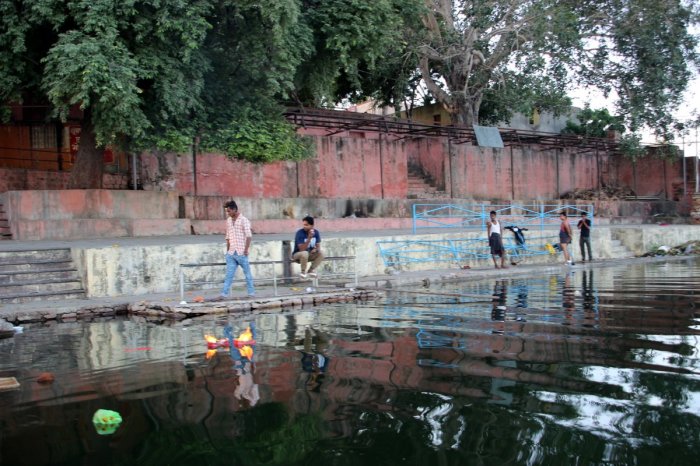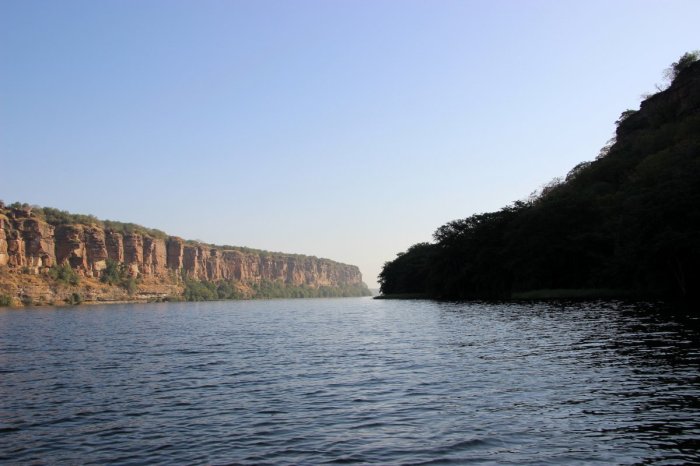“So, what are your planning to do in Kota?” asked Mahijit ji, my host in Jhalawar, over dinner on the eve of our departure for Kota.
Nothing,” I replied. “We (my friend and fellow traveller Niti & I) and reach Kota in the evening and leave for Bundi the next morning.”
“Oh, but you can’t leave Kota without going for a Chambal River Safari. It’s a morning safari, and I know just the person who can take you on it. Surely you can leave for Bundi after that?”
We said that we didn’t even know that there was something like a river safari being conducted from Kota. That’s when we heard about Ravinder Singh Tomar, nature and wildlife photographer, and the man behind the Chambal River Safari. A phone call to him later, we were booked on a 2-hour Chambal River Safari with instructions to meet him at the boating pier of Chambal Gardens in Kota from where the safari commenced.
When we reached the pier, the first thing I saw noticed was not the broad expanse of the river, but this industrial unit belching out smoke — not a very encouraging introduction to the Chambal River Safari! Our motor boat was waiting and after boarding and settling down, which hardly took a few minutes, we set off with our guide, Ravinder Singh Tomar, telling us all about the river, its history and its ecosystem.

The Chambal River is the second largest tributary of the River Yamuna. Nearly half of its 962 km length is protected for it comes under the National Chambal Sanctuary (also known as the National Chambal Gharial Wildlife Sanctuary). Perhaps, this is one of the reasons why it is able to support such a rich and diverse flora and fauna, including the Gangetic dolphins. If we were lucky, we could get to see at least one of the two varieties of crocodiles found in its waters, along with a number birds, including migratory birds.
At Kota, the Chambal used to flow about 80-100 feet below its present level till about 60 years back, and water had to be pumped up from that depth to meet the drinking water supply of Kota city. When the Kota Barrage was built in 1960 as part of the larger Chambal Valley Project, the water levels rose to its present levels.
It was difficult to imagine such low water levels, especially when I saw people bathing, praying, walking or simply watching the river flow by, as I passed them on the boat. It looked like something that had been happening for ever. It is only when Ravinder pointed out the now defunct pumping station that I could attempt to imagine what the water levels must have been like before the Kota Barrage was built.


For most part of its journey, the Chambal originates and cuts through the Vindhyan mountain ranges creating ravines and gorges. Ravinder said that while the Chambal was quite broad at Kota, it narrowed as we moved downstream and during the safari we would be passing though the beginnings of a gorge.
Soon, we had left Kota and any remnants of the city behind — the last being an almost finished cable bridge on the outskirts of the city. And then, it was only the river, rocks, vegetation, birds and us. As the safari progressed, Ravinder grew quieter except to point out birds or landmarks or to answer our questions. After a while, even the questions stopped and the only sounds to be heard was that of the boat’s engine or the occasional click of my camera.
Clicking on any of the photographs below will start a slide show on the highlights of the Chambal River Safari. You can use the arrow keys to navigate through the set, and once done, do come back to read the rest of the post.
The Chambal river and the rocks that it cuts through had me mesmerised completely. The calm and cool green waters, the red of the massive sandstone cliffs, the sudden sighting of a grey patch of shale, the variety of grasses and other vegetation growing along the banks, the sometimes feeling of being watched, the birds that I almost always missed spotting, that chance glance up at the rocks and seeing a neelgai, the changing colours of the water and the rocks as the sun ascended the skies… I was so engrossed in the surroundings that I didn’t even realise when the boat turned around to make the return journey back to Kota.
I love rivers and I revere them for the life-sustaining power that they have. And the Chambal, which is perhaps the most pristine river that I have come across, is worthy of every bit of adulation and protection that she gets. Considered to be older than the Ganga and the Yamuna, the river Chambal is also among the least polluted rivers (relatively speaking, that is) in India.
I wonder how long this will last in the face of growing development in the region as well as the over ambitious and ill-thought out Indian Rivers Inter Link Project, where the Chambal is supposed to be linked with the Ken River. Such a linkage is bound to bring about environmental and ecological changes / damage that we cannot even comprehend at this time.
It has been seven months since the Chambal River Safari and the photograph below represents what I experienced (the bright sunny side) and what the future could be like for the Chambal (the dark shadowy portion) as a result of the river linking project.

For the sake of the River Chambal and the life it has been sustaining for hundreds of years and for the sake of our future, I hope it is the sunny side that prevails.
Acknowledgements: Thank you Ravinder Singh Tomar for the illuminating Chambal River Safari, your patience in answering all our questions and sharing your passion in the area of conservation and the problems and issues faced in the region.
The Hadoti Trip Series: Dear Hadoti | Discovering Jhalawar | The painted rooms of Garh Mahal of Jhalawar | Bhawani Natyashala: The Opera House of Jhalawar | An evening in Jhalrapatan | The Buddhist rock-cut caves at Kolvi | The Gagron Fort at Jhalawar | An impact crater, a temple ruin and some discoveries | A fun evening in Kota | A safari on the Chambal River | The painted rooms of Kota Garh | The Shiva temples of Bijolia | The temples at Badoli | That and this in Bundi | The painted rooms of Bundi Palace | The stepwells of Bundi | The Hadoti Trip Planner |
Join me on Twitter, Facebook and Instagram as I explore the world around me and share “My Favourite Things” with you.




















Wow. Excellent review of Chambal river, which otherwise is surrounded by many mysteries of nature and otherwise…
LikeLiked by 1 person
For a long time Chambal was about dacoits and all things associated with it. I got to know only much later that the name came from the river.
Thank you for the appreciation, Nutsure. 🙂
LikeLike
Sure Sudha gee. That’s one region unexplored by me. When I went for the first time in late seventies there was no way I could go beyond a certain point from Morena. It was really difficult to identify the ravines and the plain land and river. Could not go beyond few miles may be less than a couple of them…
LikeLike
This sounds very interesting.
LikeLiked by 1 person
It was very, very interesting and I loved every minute of it. 🙂
LikeLike
That was an enlightening safari indeed! The photographs are really wow! Unfortunately my visit was too short and so got to only see a bit of the river from one of the less frequented ghats.
LikeLiked by 1 person
Thank you, Zephyr. Apart from being relaxing, it was good fun and a different experience as well. I now want to visit Dhaulpur where the Chambal makes an impressive bend. Hopefully one day. 🙂
LikeLike
चम्बल नदी यमुना नदी की सबसे बडी सहायक नदी है। आपका लेख देखकर मन कह रहा है कि एक ट्रिप तो इस नदी के साथ होना ही चाहिए।
रेल से यात्रा करते हुए कई बार इसे देखना हुआ, अब बारी है इसे महसूस करने की।
LikeLiked by 1 person
संदीप जी, अब तो चम्बल नदी को महसूस करने का समय आ ही गया है. देर न करें. आप कोटा, धौलपुर, या बटेश्वर से चम्बल सफारी कर सकते हैं. मैं खुद धौलपुर जाना चाहती हूँ.
LikeLike
Thanks for your informations. Do you have phone number of your guide ?? I imagine to be in Kota in october. I’m also interested with Bundi guide. I visited Bundi 2 times but did’nt see more than 5 stepwell. I’m also “crazy” with stepwell like you ( i saw many in Gujarat, Rajasthan and MP). Thanks for advanced for your answer.
Christine
LikeLike
Welcome to “My Favourite Things”, Christine. Thank you so much for stopping by and commenting here. Glad to meet another stepwell lover. I will mail you the contact details of the guides at Kota and Bundi.
Here’s wishing you a great trip to India in advance. 🙂
LikeLike